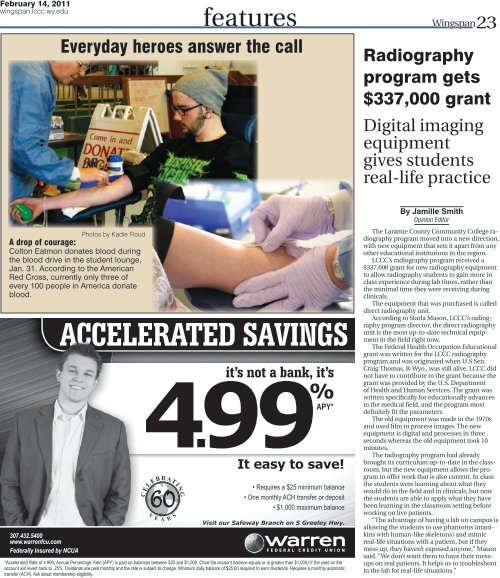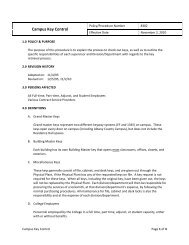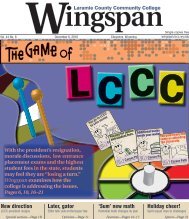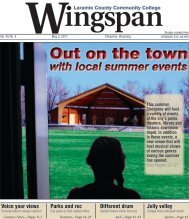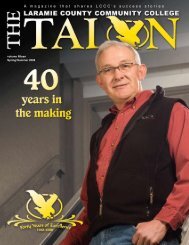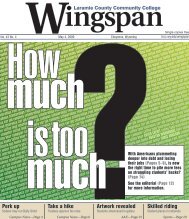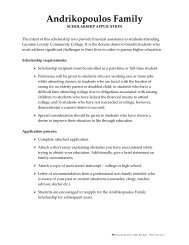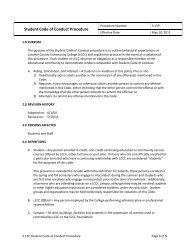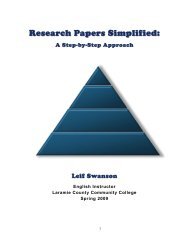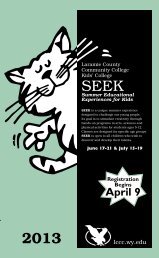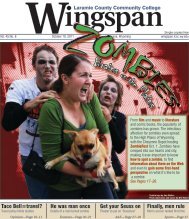February - Wingspan
February - Wingspan
February - Wingspan
You also want an ePaper? Increase the reach of your titles
YUMPU automatically turns print PDFs into web optimized ePapers that Google loves.
<strong>February</strong> 14, 2011<br />
wingspan.lccc.wy.edu<br />
features<br />
Everyday heroes answer the call<br />
<strong>Wingspan</strong>23<br />
Radiography<br />
program gets<br />
$337,000 grant<br />
Digital imaging<br />
equipment<br />
gives students<br />
real-life practice<br />
Photos by Kadie Floud<br />
A drop of courage:<br />
Colton Eatmon donates blood during<br />
the blood drive in the student lounge,<br />
Jan. 31. According to the American<br />
Red Cross, currently only three of<br />
every 100 people in America donate<br />
blood.<br />
By Jamille Smith<br />
Opinion Editor<br />
The Laramie County Community College radiography<br />
program moved into a new direction,<br />
with new equipment that sets it apart from any<br />
other educational institutions in the region.<br />
LCCC’s radiography program received a<br />
$337,000 grant for new radiography equipment<br />
to allow radiography students to gain more in<br />
class experience during lab times, rather than<br />
the minimal time they were receiving during<br />
clinicals.<br />
The equipment that was purchased is called<br />
direct radiography unit.<br />
According to Starla Mason, LCCC’s radiography<br />
program director, the direct radiography<br />
unit is the most up-to-date technical equipment<br />
in the field right now.<br />
The Federal Health Occupation Educational<br />
grant was written for the LCCC radiography<br />
program and was originated when U.S Sen.<br />
Craig Thomas, R-Wyo., was still alive. LCCC did<br />
not have to contribute to the grant because the<br />
grant was provided by the U.S. Department<br />
of Health and Human Services. The grant was<br />
written specifically for educationally advances<br />
in the medical field, and the program most<br />
definitely fit the parameters.<br />
The old equipment was made in the 1970s<br />
and used film to process images. The new<br />
equipment is digital and processes in three<br />
seconds whereas the old equipment took 10<br />
minutes.<br />
The radiography program had already<br />
brought its curriculum up-to-date in the classroom,<br />
but the new equipment allows the program<br />
to offer work that is also current. In class<br />
the students were learning about what they<br />
would do in the field and in clinicals, but now<br />
the students are able to apply what they have<br />
been learning in the classroom setting before<br />
working on live patients.<br />
“The advantage of having a lab on campus is<br />
allowing the students to use phantoms (manikins<br />
with human-like skeletons) and mimic<br />
real-life situations with a patient, but if they<br />
mess up, they haven’t exposed anyone,” Mason<br />
said. “We don’t want them to have their messups<br />
on real patients. It helps us to troubleshoot<br />
in the lab for real-life situations.”


